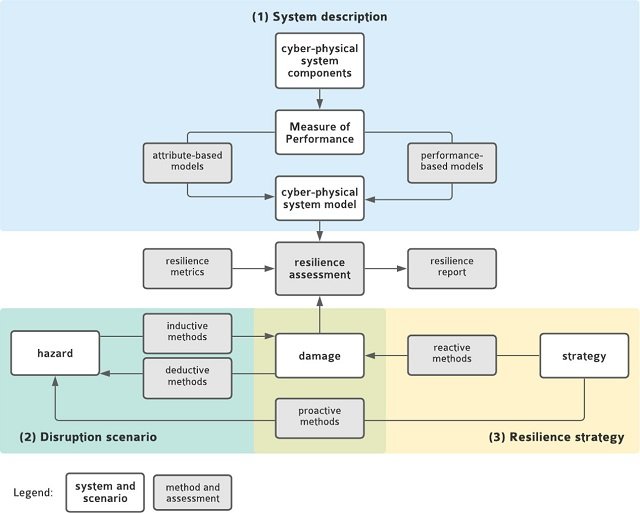
Cyber Physical Systems (CPS) represent a transformative integration of computing, networking, and physical processes, and they are emerging as one of the most important technologies of the Fourth and Fifth Industrial Revolutions. CPS are revolutionizing the engineering paradigm with profound applications in many aspects of society, including homes, energy, agriculture, healthcare, transportation, business, and manufacturing (Tushar et al., 2023).
In this article, we will explore the concept of cyber-physical systems, their principles, the challenges they face, their role in different industries, and the enormous possibilities they offer. Additionally, we will delve into various types, examples, and how security plays a crucial role in their development.
Introduction to Cyber Physical Systems
So, what exactly are cyber physical systems (CPS)? In essence, CPS combine computational algorithms with physical processes. Yao et al. (2019) indicate that cyber-physical systems aim to create a communicative interface between the digital and physical worlds by integrating computing, networking, and physical assets. Javaid et al. (2023) highlight that “cyber-physical systems” represent a new generation of integrations between physical processes and computational and networking processes.
In simpler terms, they consist of embedded computers and networks that monitor and control physical processes through a feedback loop. This connection between the physical and digital realms enables real-time interactions, leading to efficient and autonomous systems. CPS can be monitored, controlled, and operated remotely with real-time perception (El-Kady et al., 2023).
CPS are already playing a vital role in many sectors, such as healthcare, transportation, energy, and manufacturing, to improve efficiency, safety, and performance. These systems are capable of making autonomous decisions, thanks to sensors, actuators, and data networks, contributing to a smarter and more interconnected world.
History and Evolution of Cyber Physical Systems (CPS)
The concept of cyber-physical systems is not new; it dates back to the early 2000s when the National Science Foundation (NSF) recognized the potential of integrating computing with physical processes. The term “cyber-physical systems” (CPS) was officially coined by Helen Gill in 2006 at an NSF-organized workshop (Alguliyev, et al., 2018), which led to the launch of research and funding programs dedicated to CPS.
Since then, cyber-physical systems have evolved due to advancements in computing power, artificial intelligence, and networks. The widespread use of the Internet of Things (IoT) and 5G technologies has also accelerated CPS development, bringing us closer to realizing the vision of interconnected intelligent systems. In this regard, Chui et al., (2023) predict that as IoT becomes a dominant network architecture, it will play a more critical role in CPS development.
Principles of Cyber Physical Systems
The design and operation of CPS are based on several key principles, ensuring that these systems can function autonomously, securely, and efficiently:
- Integration: CPS tightly integrate computing with physical processes, meaning that software and hardware components work in tandem.
- Feedback Loops: CPS rely on continuous feedback from physical systems, using sensors to collect data and actuators to implement decisions.
- Real-Time Operations: CPS must process data and react to changes in the physical environment in real time to ensure accuracy and safety.
- Autonomy and Decision-Making: CPS can make decisions without human intervention, though this requires advanced algorithms and machine learning capabilities.
These principles enable CPS to adapt and respond to changing environments autonomously.
Types of Cyber Physical Systems
Cyber Physical Systems (CPS) can be classified into several types, depending on their complexity, functionality, and application area. Here are some of the main types:
- Networked Control Systems (NCS): These systems involve the use of network technology to remotely control physical systems.
- Embedded Systems: Small-scale Cyber Physical Systems used in everyday devices like smartphones, smartwatches, and smart home systems.
- Critical Infrastructure Systems: CPS that manage essential infrastructure such as power grids, water supply systems, and transportation networks.
- Industrial Automation Systems: Cyber Physical Systems used in manufacturing and production facilities, enabling real-time monitoring and process optimization.
- Medical Cyber-Physical Systems: These systems are used in healthcare for tasks such as real-time patient monitoring and surgical robotics.
Each of these types has specific applications and challenges, but all share the common goal of making physical systems smarter and more responsive.
Cyber Physical Systems and the Fourth Industrial Revolution
The Fourth Industrial Revolution, also known as Industry 4.0, refers to the current trend of automation and data exchange in manufacturing technologies. Cyber Physical Systems (CPS) are a key driver in this revolution as they enable the fusion of digital and physical processes.
Factories powered by cyber-physical systems are known as smart factories, where machines can autonomously communicate, make decisions, and optimize production without human intervention. This drastically improves productivity, reduces waste, and ensures a more sustainable approach to manufacturing.
Additionally, CPS play a vital role in supply chain management, logistics, and predictive maintenance, further solidifying their importance in the Fourth Industrial Revolution.
Examples of Cyber Physical Systems in Various Industries
The applications of cyber-physical systems are broad and span across different sectors, currently playing a key role in modern industry (Duo et al., 2022). Alguliyev et al. (2018) detail that CPS form the foundation for the development of smart manufacturing, smart medicine, smart buildings and infrastructure, smart cities, smart vehicles, wearable devices, mobile systems, defense systems, meteorology, and more.
Here are some notable examples of cyber physical systems in various industries:
- Healthcare: Medical CPS include pacemakers, robotic surgery systems, and real-time patient monitoring devices. These systems improve the quality of care, enable remote diagnosis, and provide real-time health data for better decision-making. The research results of Liu et al., (2023) provide an example of the use of CPS in the healthcare sector, where they explored the application of Explainable AI (XAI) in the context of medical image analysis within Medical Cyber-Physical Systems (MCPS) to improve transparency and reliability.
- Transportation: Autonomous vehicles are the primary examples of CPS in transportation, using real-time data from sensors and GPS systems to navigate roads, avoid collisions, and optimize routes.
- Energy: Smart grids use Cyber Physical Systems to control energy usage, manage distribution, and predict energy demand, ensuring a stable and efficient power supply.
- Manufacturing: In smart factories, CPS control and monitor production lines, using real-time data to optimize workflows and minimize downtime. Zhang et al., (2022) highlights that the utilization of CPS in industrial environments has led to the development of Industrial Cyber Physical Systems (ICPS), which enable cooperation within industrial facilities and across all stakeholders in the value chain. Ryalat et al., (2023) describes the design of an intelligent cyber-physical system that aligns with the innovative smart factory framework for Industry 4.0, implementing the core industrial, computing, information, and communication technologies of the smart factory.
- Agriculture: Precision agriculture techniques use CPS to monitor soil conditions, weather patterns, and crop health, allowing farmers to optimize resource use and increase yields.
- Construction: Akanmu et al., (2021) state that to accelerate innovation, digital twins and cyber-physical systems will be essential for advancing automation and real-time control with these technologies. They also describe the cyber-physical integration of emerging technologies with physical construction or the built environment, such as the next-generation digital twin and cyber-physical systems.
- Water Management: Due to the effects of climate change, water governance faces a series of challenges where CPS could play an important role. Alexandra et al., (2023) published a scientific review on the use of Cyber Physical Systems in water management and governance, highlighting their diverse roles throughout the water cycle, including in rural, urban, and coastal environments.
Challenges of Cyber Physical Systems
While CPS offer many benefits, several challenges must be addressed to unlock their full potential:
- Security Risks: As Cyber Physical Systems interact with critical infrastructure, they become targets for cyberattacks, which could have catastrophic consequences.
- Integration: Achieving seamless integration between physical systems, software, and networks remains a complex task, especially in industries with legacy infrastructure.
- Real-Time Processing: CPS must process large volumes of data in real-time, requiring advanced computing resources and algorithms capable of handling the workload efficiently.
- Regulation and Standardization: There is a need for clear regulations and standards to ensure that Cyber Physical Systems can operate safely and effectively across different industries.
Addressing these challenges is essential for the continued advancement of cyber-physical systems and their broader adoption.
Disadvantages of Cyber-Physical Systems
While CPS are highly promising, there are notable disadvantages of cyber-physical systems that should be considered:
- High cost: Implementing CPS requires substantial investment in hardware, software, and network infrastructure. The initial setup can be prohibitively expensive for smaller companies.
- Complexity: The design and maintenance of CPS can be extremely complex due to the need for close integration between physical and digital components.
- Security vulnerabilities: The interconnectivity of Cyber Physical Systems makes them vulnerable to cyberattacks, which could lead to data breaches, system failures, or even physical damage to critical infrastructure systems.
- Dependence on internet connectivity: Many CPS rely on a stable internet connection to function properly. Any disruption can cause system failures or inefficiencies.
Despite these disadvantages, the long-term benefits of Cyber Physical Systems often outweigh the drawbacks, especially when proper security and infrastructure are in place.
Cyber-Physical Systems and Security Issues
One of the most critical issues surrounding CPS is security in cyber-physical systems. Since these systems manage essential services, a breach could lead to significant disruptions, including the failure of power grids, transportation systems, or even life-saving medical devices. Duo et al. (2022) highlights that cyberattacks can cause significant damage to industrial systems, which has increasingly garnered attention from researchers and professionals.
Security in cyber-physical systems involves protecting the physical, cyber, and communication layers from attacks, ensuring that data is encrypted, access is controlled, and monitoring systems are in place to detect any anomalies. The challenge lies in creating robust security frameworks without sacrificing the performance and real-time capabilities of Cyber Physical Systems.
Canonico y Sperlì (2023) studied security issues that can affect the industrial control system (ICS) that oversees an industrial facility. They provide a classification of existing attacks based on the methodology used by the attacker and propose a classification of defensive countermeasures, including model-based and artificial intelligence approaches. Meanwhile, Somers et al., (2023) highlights the use of digital twins for security testing in cyber-physical systems.
Finally, Cassottana et al., (2023) proposes a standardized workflow framework to assess the resilience of Cyber Physical Systems (CPSs) before and after the occurrence of a disruption.

The Future of Cyber-Physical Systems
The future of cyber physical systems is both exciting and challenging. As we move forward into the era of the Fourth Industrial Revolution, cyber-physical systems will continue to drive innovation in industries such as healthcare, transportation, and energy.
With the ongoing development of AI, IoT, and edge computing, cyber-physical systems will become even more important, autonomous, and capable of handling complex tasks. However, addressing the ethical and security challenges associated with CPS will be crucial to ensuring their safe and widespread adoption.
In conclusion, cyber-physical systems represent the convergence of the physical and digital worlds, offering unprecedented opportunities for efficiency, automation, and innovation. As research and development continue, Cyber Physical Systems are likely to play an even more prominent role in shaping the future of industries worldwide.
References
Akanmu, A. A., Anumba, C. J., & Ogunseiju, O. O. (2021). Towards next generation cyber-physical systems and digital twins for construction. Journal of Information Technology in Construction, 26.
Alexandra, C., Daniell, K. A., Guillaume, J., Saraswat, C., & Feldman, H. R. (2023). Cyber-physical systems in water management and governance. Current Opinion in Environmental Sustainability, 62, 101290. https://doi.org/10.1016/j.cosust.2023.101290
Alguliyev, R., Imamverdiyev, Y., & Sukhostat, L. (2018). Cyber-physical systems and their security issues. Computers in Industry, 100, 212-223. https://doi.org/10.1016/j.compind.2018.04.017
Canonico, R., & Sperlì, G. (2023). Industrial cyber-physical systems protection: A methodological review. Computers & Security, 135, 103531. https://doi.org/10.1016/j.cose.2023.103531
Cassottana, B., Roomi, M. M., Mashima, D., & Sansavini, G. (2023). Resilience analysis of cyber-physical systems: A review of models and methods. Risk Analysis, 43(11), 2359-2379. https://doi.org/10.1111/risa.14089
Chui, K. T., Gupta, B. B., Liu, J., Arya, V., Nedjah, N., Almomani, A., & Chaurasia, P. (2023). A Survey of Internet of Things and Cyber-Physical Systems: Standards, Algorithms, Applications, Security, Challenges, and Future Directions. Information, 14(7), 388. https://doi.org/10.3390/info14070388
Duo, W., Zhou, M., & Abusorrah, A. (2022). A survey of cyber attacks on cyber physical systems: Recent advances and challenges. IEEE/CAA Journal of Automatica Sinica, 9(5), 784-800.
El-Kady, A. H., Halim, S., El-Halwagi, M. M., & Khan, F. (2023). Analysis of safety and security challenges and opportunities related to cyber-physical systems. Process Safety and Environmental Protection, 173, 384-413. https://doi.org/10.1016/j.psep.2023.03.012
Javaid, M., Haleem, A., Singh, R. P., & Suman, R. (2023). An integrated outlook of Cyber–Physical Systems for Industry 4.0: Topical practices, architecture, and applications. Green Technologies and Sustainability, 1(1), 100001. https://doi.org/10.1016/j.grets.2022.100001
Liu, W., Zhao, F., Shankar, A., Maple, C., Peter, J. D., Kim, B. G., … & Lv, J. (2023). Explainable ai for medical image analysis in medical cyber-physical systems: Enhancing transparency and trustworthiness of iomt. IEEE Journal of Biomedical and Health Informatics.
Ryalat, M., ElMoaqet, H., & AlFaouri, M. (2023). Design of a Smart Factory Based on Cyber-Physical Systems and Internet of Things towards Industry 4.0. Applied Sciences, 13(4), 2156. https://doi.org/10.3390/app13042156
Somers, R. J., Douthwaite, J. A., Wagg, D. J., Walkinshaw, N., & Hierons, R. M. (2023). Digital-twin-based testing for cyber–physical systems: A systematic literature review. Information and Software Technology, 156, 107145. https://doi.org/10.1016/j.infsof.2022.107145
Tushar, W., Yuen, C., Saha, T. K., Nizami, S., Alam, M. R., Smith, D. B., & Poor, H. V. (2023). A survey of cyber-physical systems from a game-theoretic perspective. IEEE Access, 11, 9799-9834.
Yao, X., Zhou, J., Lin, Y. et al. Smart manufacturing based on cyber-physical systems and beyond. J Intell Manuf 30, 2805–2817 (2019). https://doi.org/10.1007/s10845-017-1384-5
Zhang, K., Shi, Y., Karnouskos, S., Sauter, T., Fang, H., & Colombo, A. W. (2022). Advancements in industrial cyber-physical systems: An overview and perspectives. IEEE Transactions on Industrial Informatics, 19(1), 716-729.
Editor and founder of “Innovar o Morir” (‘Innovate or Die’). Milthon holds a Master’s degree in Science and Innovation Management from the Polytechnic University of Valencia, with postgraduate diplomas in Business Innovation (UPV) and Market-Oriented Innovation Management (UPCH-Universitat Leipzig). He has practical experience in innovation management, having led the Fisheries Innovation Unit of the National Program for Innovation in Fisheries and Aquaculture (PNIPA) and worked as a consultant on open innovation diagnostics and technology watch. He firmly believes in the power of innovation and creativity as drivers of change and development.





